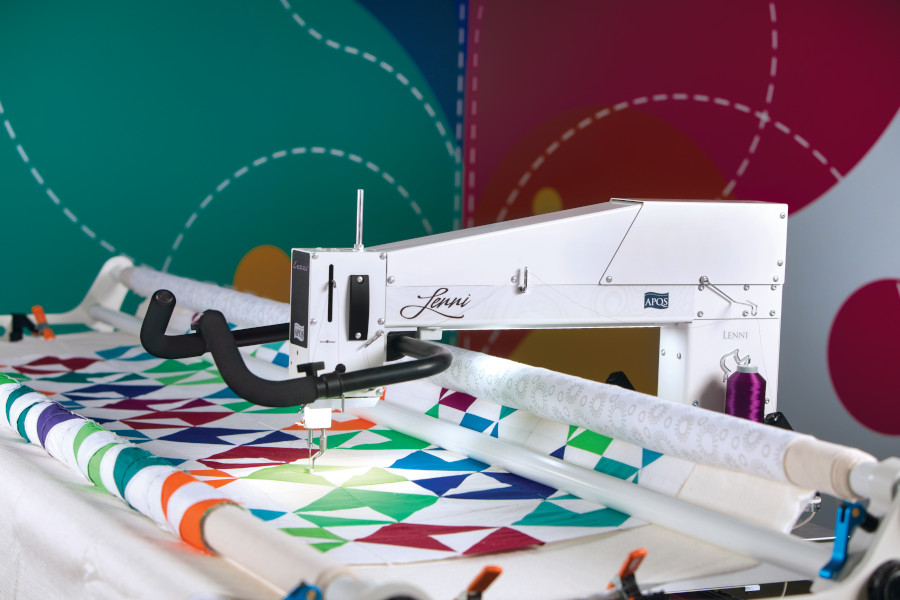How much maintenance does an APQS longarm machine need?

When quilters ask us what they should do to keep their machine working properly, they are often surprised by how little maintenance an APQS machine needs.
Since we build each machine to industrial standards for heavy-duty daily use, quilters can plan on quilting for many years before any in depth service may be required.
To keep your machine running at peak performance, simply follow these easy steps.
Check oiling wicks
First, check the four oiling wicks on top of your machine and the wick on the side. Did you notice that we said “check” the wicks, and not “oil” the wicks?
APQS machines use gravity-fed wicks to oil the sewing mechanisms instead of messy pumps or oil reservoirs as found on other brands. These wicks hold oil and release it as the mechanical parts brush by. Therefore, you only need to oil the wicks when they are dry to the touch.
In fact, over-oiling is not a good thing since the wicks can only hold so much. When they are saturated, the oil will find its way to the bottom of the sewing head, where it could eventually seep down the needle bar and on to your quilt. If you notice lots of lint and “fuzzies” clinging to the top of your needle bar, it’s a sign you’re overdoing the oiling since that oil is grabbing all the lint from your thread and batting and holding it on the needle bar. Wipe the excess off, and reduce your oiling frequency.
Remove lint build up
Just like your home sewing machine, the bobbin area on your quilting machine must be free of lint to perform correctly.
If lint builds up in the hook assembly (the part where your bobbin snaps in place) it can cause thread snarling and bird’s nests on the underside of your quilt. In addition, your needle can pick up all that lint and actually sew it right into your quilt!
Blow the lint out of the bobbin area with every bobbin change, especially if you use cotton thread or cotton batting. These two products produce lots of lint that can build up very quickly.
Since your APQS machine’s bobbin area is sealed, you can use compressed air to blow the lint out of the area. While brushing the lint out is an option, it is not as effective in getting into the “raceway” of the hook assembly as is forced air.
You can find a small, inexpensive “pancake compressor” at many home centers for under $60. This works very well for cleaning. Canned air works as well but is more expensive. Don’t shake a can of air before using it since that can cause moisture droplets to also propel into your hook along with the air. Add a drop of oil in the hook assembly about every 3-4 bobbins as directed from your manual.
Clean lint out of bobbin case
Remove the bobbin and slide the corner a business card under the tension finger on the outside of the case. The cardboard is gentler on the tension finger and won’t scratch it. Work the tip of the card toward where the thread exits the case to remove any lint under the tension finger. If lint builds up underneath that part, your bobbin case can lose tension, resulting in loops of thread on top of your quilt or bird’s nests on the back.
Don’t forget to “deep clean”
After every large project, follow the “deep cleaning” instructions that were included with your machine manual. This process uses WD 40 to bathe the hook and dislodge hidden dirt and lint. After that, you’ll use compressed air to remove excess WD 40 and then you’ll re-oil the hook assembly as normal. Keeping your machine clean and well-oiled is the single most important thing you can do to maintain your machine for years and years of carefree quilting.
Change your needle frequently
While your APQS machine uses an industrial needle, it’s a good practice to change the needle with every quilt project to be safe. It only takes a small burr to cause tufting on the back of your quilt where the batting pokes out the back.
For additional tips on maintaining your APQS machine, our customer support team is here to help. Coupled with a lifetime warranty on our new machines, you know that your quilting machine is meant to last and last.



